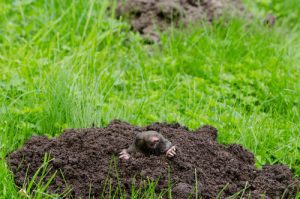Mole Tunnels Everywhere!
By Chris Williams on July 21, 2011.
Q. What do mole tunnels look like? I think that’s what I have all over my yard but I’ve never seen a mole. There are lots of holes, too. Do moles leave holes?
A. You don’t usually see moles. Moles spend almost all their time in their underground burrows, rarely coming to the surface. They are loners occupying a large home range. Moles like loose, moist soil with an abundance of grubs. They are rarely a problem where soil is hard, compact, and dry.
Certain characteristics of the burrows and runways can tell you if moles are the problem. Moles dig two types of tunnels: surface (hunting) tunnels and deep (nesting) tunnels. You can’t see the nesting tunnels but you may see a “mole hill,” a pushed up mound of soil nearby. Moles often nest and rest under mulched garden beds or compost piles. They then move from these areas out into the lawn. The surface tunnels that they travel through are shallow runways that can be seen as raised ridges on the ground. They are usually in areas that are shady and cool while the deeper nest tunnels are in higher, drier spots. Both types of tunnels are often found along edges of a fence, hedge, sidewalk, or other man-made border.
 The twisting, hunting runways are 5 to 8 inches beneath the surface of the ground and 1-1/4 to 1-1/2 inches in diameter. These surface tunnels tend to be shallower in spring and fall during wet weather, and deeper in summer and winter during dry or cold weather. The mole uses its large front claws to “swim” through the soil in these runways searching for worms, grubs, and other insects.
The twisting, hunting runways are 5 to 8 inches beneath the surface of the ground and 1-1/4 to 1-1/2 inches in diameter. These surface tunnels tend to be shallower in spring and fall during wet weather, and deeper in summer and winter during dry or cold weather. The mole uses its large front claws to “swim” through the soil in these runways searching for worms, grubs, and other insects.
Since surface hunting tunnels are often used only once or twice and then abandoned, the number of tunnels in an area is not a good indicator of the number of moles present. While it may look like there’s an entire army of moles working your yard, 3 to 5 moles/acre is considered a high population.
After rains or when mole surface tunnels have not been used for awhile, they begin caving in. Holes appear where the tunnel has collapsed, sometimes over a large area, and can be confused with rodent burrows. To determine which runways are active (this is important to know if you are going to be baiting or trapping), poke a hole in the runway with your finger or a dowel. An active runway will be repaired, usually within a few hours. If you kick a mole hill and find fresh dirt inside, that’s also a sign of recent activity.
Moles often get blamed for damage to plants and bulbs that is actually caused by voles or mice. Moles are insectivores and don’t eat plants. Voles are vegetarians and will clip off and feed on plants. Voles often use mole runways as travel routes to reach their food source (mostly seeds and roots). Mice and shrews use mole tunnels as well.